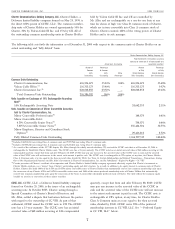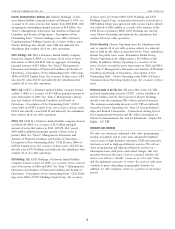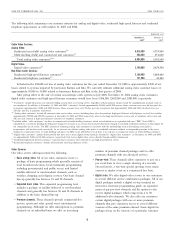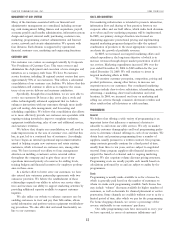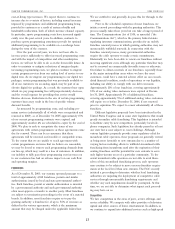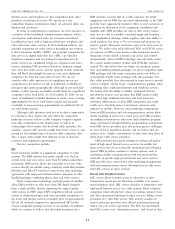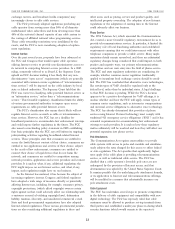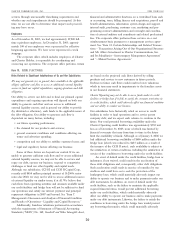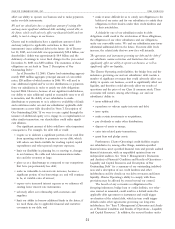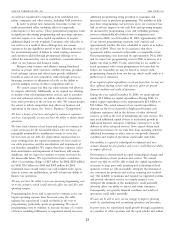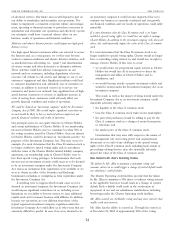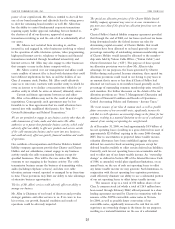Charter 2005 Annual Report Download - page 25
Download and view the complete annual report
Please find page 25 of the 2005 Charter annual report below. You can navigate through the pages in the report by either clicking on the pages listed below, or by using the keyword search tool below to find specific information within the annual report.
CHARTER COMMUNICATIONS, INC. 2005 FORM 10-K
classification removed DSL service from many traditional including Internet services, in competition with our existing or
telecommunications regulations. Legislative action and the potential interactive services ventures and businesses. Telephone
FCC’s decisions and policies in this area are subject to change. companies can lawfully enter the cable television business and
We expect DSL to remain a significant competitor to our data some telephone companies have been extensively deploying
services, particularly as we enter the telephone business and fiber in their networks, which enables them to provide video
telephone companies aggressively bundle DSL with telephone services, as well as telephone and Internet access service. At
service to discourage customers from switching. In addition, the least one major telephone company plans to provide Internet
continuing deployment of fiber by telephone companies into protocol video over its upgraded network and contends that its
their networks will enable them to provide higher bandwidth use of this technology should allow it to provide video service
Internet service than provided over traditional DSL lines. without a cable franchise as required under Title VI of the
DSL and other forms of high-speed Internet access provide Communications Act. Telephone companies deploying fiber
competition to our high-speed Internet service. For example, as more extensively are already providing video services in some
discussed above, satellite-based delivery options are in develop- communities. Although telephone companies have obtained
ment. In addition, local wireless Internet services have recently franchises or alternative authorizations in some areas and are
begun to operate in many markets using available unlicensed seeking them in others, they are attempting through various
radio spectrum. This service option, popularly known as ‘‘wi-fi’’, means (including federal and state legislation and through FCC
offers another alternative to cable-based Internet access. rulemaking) to weaken or streamline the franchising require-
High-speed Internet access facilitates the streaming of video ments applicable to them. If telephone companies are successful
into homes and businesses. As the quality and availability of in avoiding or weakening the franchise and other regulatory
video streaming over the Internet improves, video streaming requirements that are applicable to cable operators like Charter,
likely will compete with the traditional delivery of video their competitive posture would be enhanced. We cannot
programming services over cable systems. It is possible that predict the likelihood of success of the broadband services
programming suppliers will consider bypassing cable operators offered by our competitors or the impact on us of such
and market their services directly to the consumer through competitive ventures. The large scale entry of major telephone
video streaming over the Internet. companies as direct competitors in the video marketplace could
We believe that pricing for residential and commercial adversely affect the profitability and valuation of established
Internet services on our system is generally comparable to that cable systems.
for similar DSL services and that some residential customers Charter provides telephone service over our broadband
prefer our ability to bundle Internet services with video services. communications networks in a number of its service areas.
However, DSL providers may currently be in a better position Charter also provides traditional circuit-switched phone service
to offer data services to businesses since their networks tend to in a few communities. In these areas, Charter competes directly
be more complete in commercial areas. They also have the with established telephone companies and other carriers, includ-
ability to bundle telephone with Internet services for a higher ing VoIP providers, for voice service customers. As we expand
percentage of their customers, and that ability is appealing to our offerings to include voice services, we will be subject to
many consumers. Joint marketing arrangements between DSL considerable competition from telephone companies and other
providers and DBS providers may allow some additional telecommunications providers. The telecommunications industry
bundling of services. Moreover, major telephone companies, is highly competitive and includes competitors with greater
such as AT&T and Verizon, are now deploying fiber deep into financial and personnel resources, who have brand name
their networks that enables them in some areas to offer high recognition and long-standing relationships with regulatory
bandwidth video services over their networks, in addition to authorities and customers. Moreover, mergers, joint ventures and
established voice and Internet services. alliances among franchise, wireless or private cable operators,
local exchange carriers and others may result in providers
Telephone Companies and Utilities capable of offering cable television, Internet, and telecommunica-
The competitive environment has been significantly affected by tions services in direct competition with us. For example, major
technological developments and regulatory changes enacted local exchange carriers have entered into arrangements with
under the 1996 Telecom Act, which amended the Communica- EchoStar and DirecTV in which they will market packages
tions Act and which is designed to enhance competition in the combining phone service, DSL and DBS services.
cable television and local telephone markets. Federal cross- Additionally, we are subject to competition from utilities
ownership restrictions historically limited entry by local tele- which possess fiber optic transmission lines capable of transmit-
phone companies into the cable business. The 1996 Telecom ting signals with minimal signal distortion. Utilities are also
Act modified this cross-ownership restriction, making it possible developing broadband over power line technology, which will
for local exchange carriers, who have considerable resources, to allow the provision of Internet and other broadband services to
provide a wide variety of video services competitive with homes and offices. Utilities have deployed broadband over
services offered by cable systems. power line technology in a few limited markets.
Telephone companies already provide facilities for the
transmission and distribution of voice and data services,
15




